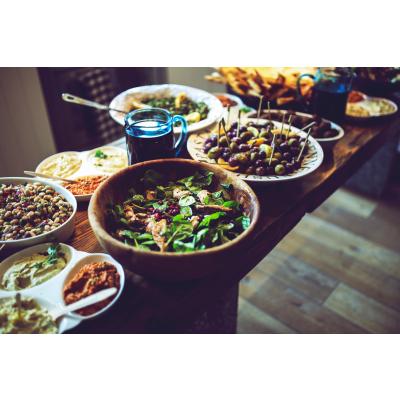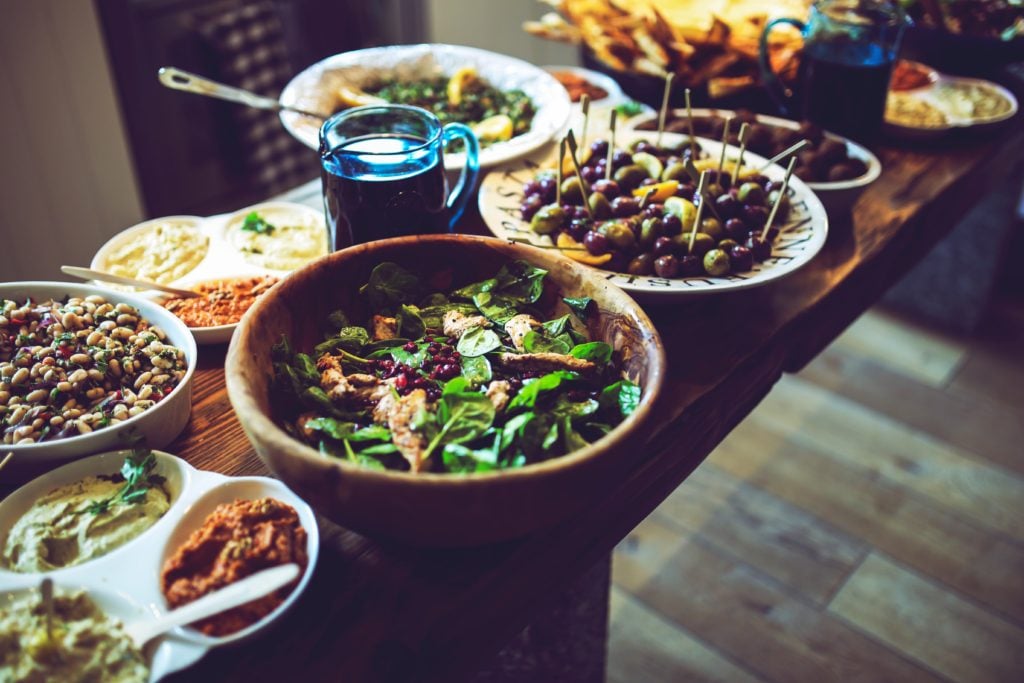
Posted in: World Wedding Customs
 Medieval wedding feasts lasted three days. Plenty of food, feasting, drinking, and merriment accompanied the festivities. Photo by Kaboompics .com from Pexels.
Medieval wedding feasts focused primarily on the food. Believe it or not, at least two important books dictated the rules of etiquette for feasts. Typically, the most important people sat higher than the rest. They called this the high table. Not surprisingly, the central places of honor at the high table belonged to the bride and groom, even though their parents ranked higher in society than they did.
Medieval wedding feasts lasted three days. Plenty of food, feasting, drinking, and merriment accompanied the festivities. Photo by Kaboompics .com from Pexels.
Medieval wedding feasts focused primarily on the food. Believe it or not, at least two important books dictated the rules of etiquette for feasts. Typically, the most important people sat higher than the rest. They called this the high table. Not surprisingly, the central places of honor at the high table belonged to the bride and groom, even though their parents ranked higher in society than they did.
Medieval Wedding Feast Etiquette
Medieval feasts began in the kitchen with the servants. Cooks, scullions, spit-turners, and servers. Furthermore, those in attendance brought their own servants and pages. Perhaps as many as 200 servants served a party consisting of an equal number of guests. The guests sat at two long tables arranged perpendicular to the high table. Those of high rank received cushions, while those of lower rank sat directly on the hard stools. Typically, the guests sat on only one side of the tables, allowing ease of access for the servants to deliver and clear the platters of food. The wedding party arrived from the church on horseback. Upon their arrival, the Lord and Lady of the manor, as well as the bride and groom, took their places at the high table. Until they sat, their guests remained standing.Medieval Wedding Foods
Food took pride of place at a medieval wedding feast. A range of meats included roasted mallard, pheasant, woodcocks, and partridges. Of course, a roasted boar's head with an apple in its mouth centered the tables. Breads proved a staple for sopping up the heavily spiced sauces and glazes. Open pork pies, stuffed chickens, and pottages (soups made with meat and vegetables) delighted the tongue, as well. Other fare included eel, tench, or tuna fish, as well as brawn (headcheese) and fritters (batter-fried meats and fruits). Of course, a medieval feast would not be complete without spiced wine (sometimes thickened with egg yolks), assorted cheeses, and sweet desserts. Servants brought the food out in courses, anywhere from three to seven. Each course presented a variety of foods, beginning with the lightest fare, moving toward heavier and heavier fare. Servers offered fruit and pottages first. Then, they brought out the roasted meats. Next, pies, tarts, and pastries. Finally, they presented candied fruits, wafers, and cheeses.Decorations & Entertainment
Wedding feasts took place in large halls. Servants decorated the walls with tapestries and the floor with rushes scattered with flowers. The most popular wedding flowers included lilies and roses. Servants presented the food on wooden and pewter platters. Each guest brought their own spoon, knife, and drinking vessel. Though knives were made of metal, spoons and mugs were made of wood, bone, or clay. Guests used their left hand to reach for shared foods. During a wedding feast, the guests waited for the bride and groom to drink from the love cup. Shaped like a trophy, the love cup had two handles. The groom drank a big gulp first, then the bride finished off the wine. Finally, the bride and groom took their first bites of food, allowing their guests to follow suit. Between courses, the servants cleared all the dishes and wiped down the tables before serving the next course. During the cleanup, minstrels, bards, and musicians entertained the guests. Love songs, poetry, and epic tales of heroic love proved the most popular form of wedding entertainment. During this time, guests brought gifts to the newlyweds, as well. The female members of the groom's family offered the bride heirloom rings passed down from one generation to the next. These rings welcomed the bride into her new family. The bride and groom also gave small tokens of appreciation to their guests during these interludes. As the end of the first feast day came to a close, friends and family members escorted the bride and groom to their antechambers.Blessing of the Nuptial Bed
While servants and close friends dressed the bride and groom for bed, servants decorated the nuptial bed with rose petals. Friends and family members then crowded into the bedroom, as many of them as possible. Finally, servants ushered the bride and groom into the crowded room. At that time, a priest performed a ceremony ensuring fertility and blessings upon their union. He also performed a ritual which removed any stain of prior sexual encounters away from the bride. The priest ended with a final invocation of blessing, and then everyone left the bride and groom alone. The feasting began anew in the morning and carried on for another two days. ~Angela Magnotti Andrews5 years ago
100 view(s) 